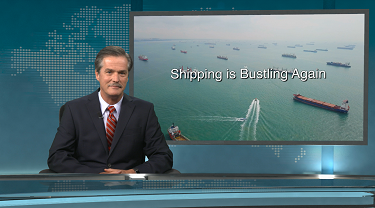Most agree that the global economy is hot. Those with a great stake in their predictions are bullish, in spite of significant headwinds. Conditions like this usually fire up global seaborne trade, and in the past have put total shipping capacity under severe pressure. With other key indicators red-lining, are we headed for another crunch in global shipping?
Recent stats are impressive. The Baltic Exchange Dry Index, which measures the shipping rates charged for transporting dry bulk goods all over the world, is on a roll. It surged at the end of last year, dipped in the opening months of this year, but since April has surged by 72 per cent to get back up to the recent peak levels seen last December. It hasn’t been this high since a double-jump at the end of 2013, and it suffered in the wake of the global softening in commodity prices in mid-2014. Larger ships are pushing the upward movement, again a positive sign of hefty goods movement. The recent surge is creating excitement, and more stories on this neo-revival are hitting the airwaves.
Container shipping is seeing something similar. The Harpex index is the parallel to the Baltic Dry for the container shipping world. Like the Baltic, the Harpex is hovering around 7-year highs, thanks to a surge in activity that dates back to mid-2016. In fact, since then, the overall Index has doubled. In this case, the increases are shared among ship sizes, with only the smallest class of ships (700 TEU) not moving as much.
The key reason these movements are exciting market watchers is that they really do seem to be marking a change from the industry’s general experience in the post-recession period. Global economic growth is indeed translating into greater trans-ocean shipments of goods and services, with the hope that it reverses the carnage experienced by international trade when activity levels plummeted in 2009.
There is a reality check on the enthusiasm, though. Although rising remarkably, these two key indexes are far from their cyclical peaks. In fact, at current levels, they probably qualify for early-to-mid cycle status. For most ship size categories, sub-indexes are at levels less than half of what they were in 2007-08. And if we want to talk capacity crunch, then we have to go back to 2004, when charter rates for ships reached unthinkable highs 40 per cent greater than the 2007-08 levels. Put it on a chart, and today’s surge is reduced to a fairly minor blip.
That’s a shock; according to some, aren’t we at the peak of the cycle now, or close to it? Here’s one of the economy’s current conundrums: some indicators sure look like they’re in the peak zone, but others are well within previous limits. Pundits are at unusual odds with each other over timing; for the most part, it is clear to most economy-watchers when we are getting close to the end of the cycle. Today, it could hardly be more confused. So, how do we read the shipping sector signals?
Like other select sectors of the economy, shipping is one that still has a lot of surplus capacity. Back in 2004, capacity was tested by hot global demand, a dearth of available ships and a port logjam along the west coast of North America. The crisis, together with sky-high ship lease rates, prompted a deluge of investment – in transportation infrastructure of all kinds, and also in shipbuilding. The sense at the time was that globalization and the unending rapid expansion of emerging markets guaranteed that the pressure was here to stay, and that we couldn’t build enough of both infrastructure or ships.
Against those predictions, we ended up with an ill-timed glut of both. Data from UNCTAD illustrate the situation all too well. The average rate of product tonnage to shipping capacity is currently at about 78 per cent of what is was in 1998, and about 30 per cent below peak utilization. Put another way, it appears that there are so many surplus ships that on average, vessels are running 80 per cent full, 20 per cent of available ones are idled, or all ships are running about 80 per cent as often as before. It’s not great news for the shipping industry, as reflected in lease rates.
There is, however, a silver lining. If the world economy continues to grow, then a lack of shipping capacity will not hold it back. Ramp things up further, and we are not talking 2004 – far from it. If a capacity-crunch recession is on the way (which we believe is unlikely), this time no one will blame ocean-going vessels.
Global shipping is taking off – but is still far from previous heights. Exporters with rising order books can count on ocean-going capacity and contained increases in freight rates. From this industry’s perspective, recession is still a long way off.





